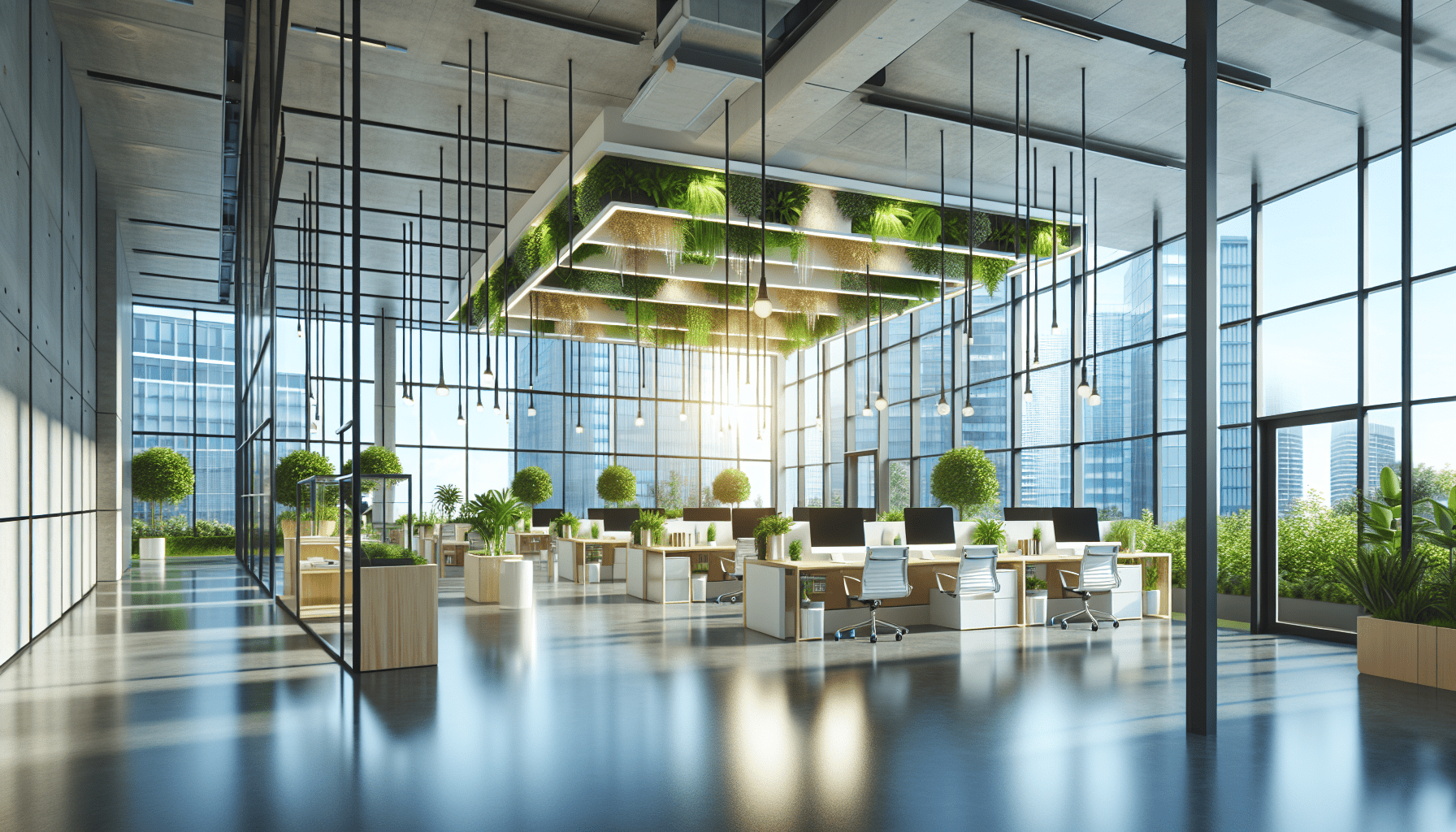Hey everyone! Imagine walking into a workspace that not only looks beautiful but also enhances our well-being and efficiency. In our latest article, “How Can Sustainable Architecture Improve Productivity In Workplaces?” we explore how sustainable design principles can transform our everyday work environment. By incorporating elements like natural lighting, improved air quality, and energy-efficient materials, we’ll discover how these eco-friendly choices can lead to happier and more productive teams. Join us as we delve into the fascinating intersection of sustainability and workplace productivity! How Can Sustainable Architecture Improve Productivity In Workplaces?
Have you ever wondered how the buildings we spend our days in might influence our productivity and overall well-being? As we evolve in our understanding of workplace efficiency and employee satisfaction, one angle stands out: sustainable architecture. It’s more than just a trendy buzzword. It’s a comprehensive approach to designing, constructing, and operating buildings to be environmentally responsible and resource-efficient throughout their life cycles.
The Core Principles of Sustainable Architecture
Before diving into how sustainable architecture can boost productivity in workplaces, let’s first define the core principles that underpin this approach. Understanding these will help us appreciate the link between sustainable design and enhanced workplace productivity.
Energy Efficiency
The goal here is to minimize energy consumption through various means, such as optimizing natural light, using energy-efficient appliances, and enhancing insulation. This not only lowers utility bills but also creates a more comfortable work environment.
Use of Sustainable Materials
Employing materials that are recycled, recyclable, or sustainably sourced minimizes the ecological footprint of a building. These materials often have benefits like lower toxicity and better durability, contributing to a healthier workspace.
Water Efficiency
Smart plumbing systems, water recycling, and rainwater harvesting are part of this principle. Efficient water use ensures that resources are conserved and operational costs are reduced.
Indoor Environmental Quality (IEQ)
IEQ focuses on the quality of a building’s indoor environment, which includes air quality, lighting, and acoustics. Superior IEQ leads to fewer health issues and enhanced work performance.
Site Optimization
This involves thoughtful site selection and building orientation. By maximizing natural elements, like sunlight and wind, a building can operate more efficiently and provide a better quality of life for its occupants.
The Relationship Between Sustainable Architecture and Productivity
Now, let’s explore how these principles translate into a more productive workplace. The connection might not be immediately obvious, but the impact is profound when you consider how our environments affect our health, mood, and efficiency.
Enhanced Air Quality
Poor air quality can lead to several health issues, including respiratory problems and cognitive function decline. By utilizing better ventilation systems and incorporating more plants, sustainable buildings can significantly improve indoor air quality.
Statistics:
| Element | Traditional Buildings | Sustainable Buildings |
|---|---|---|
| CO2 Levels | High | Low |
| Airborne Pollutants | High | Low |
| Employee Sick Days | More Frequent | Less Frequent |
Optimized Natural Lighting
Natural light has been shown to have a positive impact on mood and energy levels. By thoughtfully designing windows and openings to maximize daylight, sustainable buildings reduce the reliance on artificial lighting, which can cause eye strain and fatigue.
Key Benefits:
- Enhanced Mood
- Reduced Eyestrain
- Better Sleep Patterns
Thermal Comfort and Energy Efficiency
Nobody likes to work in an environment that’s too hot or too cold. Sustainable buildings maintain a stable indoor temperature through advanced insulation and efficient HVAC systems, providing a comfortable workspace year-round.
Improved Acoustics
Sound pollution can be a major distraction in a workplace. Sustainable architecture employs materials and designs that mitigate unnecessary noise, ensuring a quieter and more focused work environment.
Noise Reduction Practices:
- Use of sound-absorbing materials
- Strategic placement of workstations
- Designated quiet zones
Access to Nature
Incorporating green spaces, such as rooftop gardens and indoor plants, not only improves air quality but also offers a psychological boost. Nature-inspired spaces can reduce stress and inspire creativity.
Flexible and Adaptable Spaces
Sustainable design often includes versatile spaces that can be easily reconfigured to meet changing needs. This flexibility supports various work styles and functions, fostering collaboration and innovation.
Case Studies: Real-World Applications
To better illustrate these points, let’s look at some real-world examples where sustainable architecture has directly impacted workplace productivity.
The Edge, Amsterdam
Often referred to as the most sustainable office building in the world, The Edge uses a combination of natural light, smart technology, and sustainable materials to create an ultra-efficient workspace. Employees report higher satisfaction levels, and the building boasts a substantial decrease in energy consumption.
Bullitt Center, Seattle
Dubbed the “greenest commercial building” in the world, the Bullitt Center employs rainwater collection, composting toilets, and rooftop solar panels. The design not only minimizes environmental impact but also enriches the work environment, leading to increased employee well-being and productivity.
One Central Park, Sydney
This mixed-use building incorporates vertical gardens and highly efficient water and energy systems. Employees in offices within this development benefit from the natural green spaces, reporting improved mental wellness and focus.
Overcoming Challenges in Implementing Sustainable Architecture
While the benefits are clear, implementing sustainable architecture in workplaces is not without its challenges. Understanding these obstacles can help us better navigate them.
Initial Costs
One of the primary concerns is the higher upfront cost of sustainable materials and technologies. However, these investments often lead to long-term savings through reduced energy and maintenance costs.
Technical Complexity
Implementing sustainable systems can be technically challenging, requiring specialized knowledge and expertise. Partnering with skilled professionals can mitigate these challenges.
Regulatory Hurdles
Navigating zoning laws, building codes, and other regulatory requirements can be complex. Staying informed about local regulations and working with experienced architects can simplify this process.
Employee Adaptation
Introducing new sustainable practices may require a cultural shift within the organization. Effective communication and training can ease this transition.
The Role of Technology in Sustainable Architecture
Technology plays a crucial role in enabling sustainable architecture. Innovative tools and systems make it easier to achieve and maintain sustainable buildings.
Building Information Modeling (BIM)
BIM allows for precise planning and management of a building’s lifecycle, ensuring all sustainability measures are integrated effectively.
Smart Building Systems
Automated systems for lighting, heating, and cooling can optimize energy use based on occupancy and weather conditions.
Renewable Energy Solutions
Solar panels, wind turbines, and geothermal systems can provide clean, renewable energy, reducing reliance on fossil fuels.
Water Recycling Technologies
Innovative systems for water recycling and rainwater harvesting can significantly reduce water consumption.
Future Trends in Sustainable Architecture
The field of sustainable architecture is continually evolving. Here are some trends that are likely to shape the future.
Biophilic Design
This approach integrates natural elements into built environments, fostering a strong connection to nature and improving well-being and productivity.
Net-Zero Buildings
These buildings produce as much energy as they consume, dramatically reducing their environmental impact.
Adaptive Reuse
Repurposing old buildings for new uses preserves resources and retains cultural heritage while creating modern, sustainable workspaces.
Circular Economy Principles
Designing for a circular economy involves creating buildings with materials that can be easily reused or recycled, minimizing waste.
How Organizations Can Embrace Sustainable Architecture
Embracing sustainable architecture is a strategic move that can yield considerable benefits. Here’s how organizations can begin this journey.
Conducting a Sustainability Audit
Assessing current practices and identifying areas for improvement is the first step. This audit should encompass energy use, waste management, water consumption, and materials sourcing.
Setting Clear Goals
Establishing specific, measurable, and achievable sustainability goals provides a roadmap for action. These goals should align with broader organizational objectives.
Partnering with Experts
Collaborating with architects, engineers, and sustainability consultants is crucial for successfully implementing sustainable practices.
Educating Employees
Building a culture of sustainability involves educating employees about the importance of sustainable practices and how they can contribute.
Monitoring and Reporting Progress
Regularly monitoring progress and reporting on sustainability efforts helps maintain momentum and accountability.
Conclusion: The Business Case for Sustainable Architecture
We’ve explored the myriad ways in which sustainable architecture can enhance productivity in workplaces, from improving air quality to providing flexible spaces that support diverse work styles. Sustainable architecture isn’t just about being environmentally responsible; it’s about creating healthier, more efficient, and more productive workplaces.
By overcoming the initial challenges and leveraging technological advancements, organizations can unlock the full potential of sustainable architecture. The future is green, and the benefits—from increased employee well-being to significant cost savings—make a compelling case for embracing sustainable architecture in our workplaces.
Let’s commit to building spaces that not only respect our planet but also empower us to do our best work. After all, a sustainable workplace is a productive workplace, where both the environment and people can thrive.




